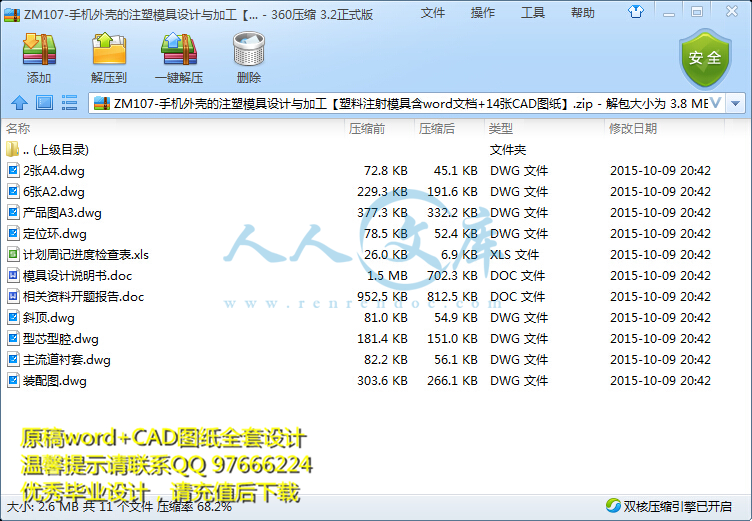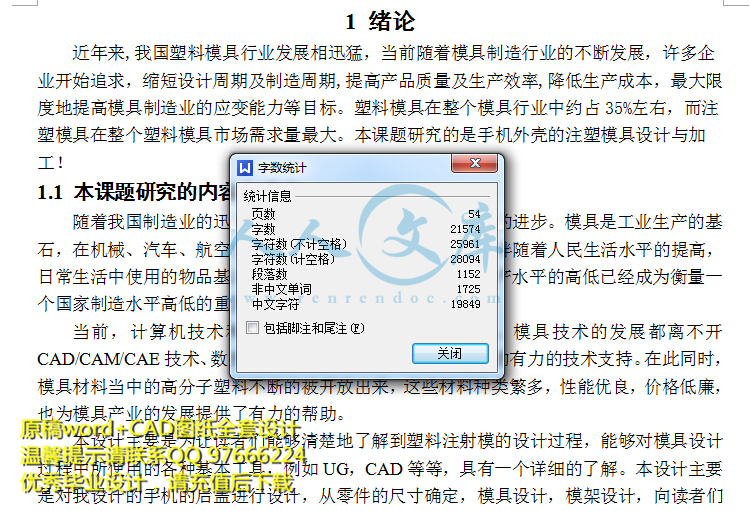!【详情如下】【注塑塑料模具类】CAD图纸+word设计说明书.doc[21000字,54页]【需要咨询购买全套设计请加QQ97666224】.bat
2张A4图纸.dwg
6张A2图纸.dwg
主流道衬套.dwg
产品图A3.dwg
型芯型腔.dwg
定位环.dwg
斜顶.dwg
装配图.dwg
设计说明书.doc[21000字,54页]
相关资料开题报告.doc
计划周记进度检查表.xls
毕 业 设 计论 文 任 务 书
一、题目及专题:
1、题目 机械设备模具的计算机设计与加工
2、专题 手机外壳的注塑模具设计与加工
二、课题来源及选题依据
该设计来源于某模具公司,该产品为手机背面外壳,要求设计一套模具来生产它,预估产量比较大,所以设计为一模两腔,在随着国民经济的高速发展的同时,市场对模具的需求量也不断的增长。人们已经越来越清楚认识到产品质量、成本和新产品开发能力的重要性。模具设计与制造技术现已成为衡量一个国家制造业水平高低的重要标志,并在很大程度上决定了企业的生存空间。现在,模具设计与制造行业追求的目标是提高产品质量及生产效率、缩短设计及制造周期,降低生产成本、最大限度提高模具制造业的应变能力,满足用户需求。而手机模具设计与加工更是模具设计与加工的主流。
三、本设计(论文或其他)应达到的要求:
1.熟悉模具设计与加工的发展历程;
2.熟练掌握模具设计所需`要的软件CAD、UG等;
3.熟练掌握模具各零件所用钢材的种类以及注塑原料种类与特性;
4.掌握模具设计与加工的一般流程并了解模具结构;
5.能够根据产品结构设计出符合要求的模具撰写毕业设计论文;
摘 要
随着经济全球化的不断深化,模具工业在一部分国民经济中起着越来越明显的作用。产品的质量的好坏以及生产效率的高低与模具水平的高低息息相关。
首先此次毕业设计主要完成手机外壳注射模具的设计,设计中分析了手机外壳零件的结构及工艺性,确定该塑件的注塑成型方案并进行了注射模设计方面的相关计算。其次利用UG软件的CAD模块对手机外壳注射模进行三维曲面造型。本模具主要难点是采用了侧抽芯。模具结构紧凑、工作可靠、操作方便、运转平稳、冷却效果好、劳动强度低、生产效率高、生产的塑件精度高、生产成本低。本文从型腔数量和布局的确定、注射机选择、流道的设计、模板及其标准件的选用、冷却系统、成型部件的设计等给出了详细的设计过程。
注射模具设计是一个需要很多的经验的模具设计,所以我们可以利用各种设计经验与理论相结合的方式使得该设计更加完美。UG软件是一个极好的工具,可用于现代的成型加工与模具设计。
关键词:注塑模;三维曲面造型;UG;CAD
Abstract
With the deepening of the economic globalization, the die industry Plays a more and more obvious part in the national economy. Closely related to the level of quality of the product is good or bad, as well as the level of production efficiency and the level of mold.
I finished the design of the injecting mold of Mobile phone shell firstly. The process includes the analyzing of the structure and crafts of the cellular Mobile phone shell, deciding the way of the injecting and doing certain calculation relating to the injecting-mold. Then make the modeling of the machinery in the way of three-dimension camber making use of the CAD part from UG The main difficulty of the mold is a side core. Advanced cohesive, working, reliable, easy to operate, smooth operation, good cooling effect, low labor intensity, production efficiency, the integrated production of high accuracy, low cost of production. The number and layout from Xingqiang identification, injection machine selection, flow Road design, the choice of standards and templates, cooling systems, shaped components of the design gives detailed design process.
The design of the injecting mold is one which need lots of experience, so we can make use of various of designing experience that must be combined with the theory ,which is the way making the design more perfect. The software of UG is a excellent tool used in the design of modern molding and machining.
Keywords: injecting mold; three-dimention camber mold; UG; CAD
目 录
摘 要III
AbstractIV
目 录V
1 绪论1
1.1 本课题研究的内容和意义1
1.2 模具工业国内外发展的概况1
1.3 本课题应达到的要求2
2 手机外壳的设计及其成型工艺的分析3
2.1 产品功能分析3
2.2 塑件背面外壳分析3
2.2.1 结构分析如下4
2.2.2 成型工艺分析4
2.3 塑料的选材及性能分析4
2.3.1 使用特点:4
2.3.2 成型特性:4
2.3.3 ABS的主要性能指标4
2.4 ABS塑料的注射过程及工艺5
2.4.1 注射成型过程5
2.4.2 ABS的注射工艺参数5
2.5 ABS的主要缺陷及消除措施6
2.5.1 龟裂6
2.5.2 熔接缝6
2.5.3 收缩6
2.5.4 烧焦纹6
3 模具设计方案的确定8
3.1 分型面方案的确定8
3.1.1 分型面的选择原则8
3.1.2 分型面确定8
3.2 型腔数量确定及排列形式8
3.2.1 多型腔模具排列形式设计的要点:8
4 模具设计10
4.1 注塑机选型10
4.1.1 注射量计算10
4.1.2 注射机型号的选定10
4.1.3 型腔数量的校核及注射机有关工艺参数的校核11
4.2 模具浇注系统设计和浇口的设计13
4.2.1 主流道的设计13
4.2.2 分流道与浇口的设计15
4.3 成型零件工作尺寸的设计和计算15
4.3.1 型芯16
4.3.2 型腔17
4.3.3 型腔零件刚度和强度校核18
4.3.4 成型零件钢材的选用18
4.4 模架的确定和标准件的选用18
4.5 合模导向机构和定位机构19
4.5.1 导向机构的总体设计19
4.5.2 导柱设计20
4.5.3 导套设计20
4.6 脱模推出机构的设计21
4.6.1 推出机构的组成21
4.6.2 推出机构的分类21
4.6.3 脱模推出机构的设计原则21
4.6.4 塑件的推出机构21
4.6.5 脱模力的计算22
4.7 斜顶与抽芯机构设计23
4.7.1 侧向分型与抽芯机构类型的确定23
4.7.2 斜顶的设计23
4.7.3 各项尺寸的计算与校核23
4.8 排气系统设计24
4.9 冷却系统的优化设计24
4.9.1 加热系统24
4.9.2 冷却系统24
4.9.3 冷却装置布置方案26
4.10 模具材料例表27
4.11 尼龙胶钉27
4.11.1 特点27
4.11.2 型号28
5 塑胶模具的加工方法及工艺29
5.1 常用加工工具及机器29
5.2 加工方法及工艺29
6 模具装配30
6.1 塑料模具装配的技术要求30
6.2 塑料模具装配过程30
6.2.1 装配动模部分30
6.2.2 装配定模部分31
7 模具的试模与修模33
7.1 制品的粘着33
7.2 成型缺陷33
7.3 注射填充不足34
7.4 注射工艺不足34
7.5 次品分析35
8 结论与展望36
8.1 结论36
8.2 展望36
致 谢37
参考文献38
附 录39










 川公网安备: 51019002004831号
川公网安备: 51019002004831号